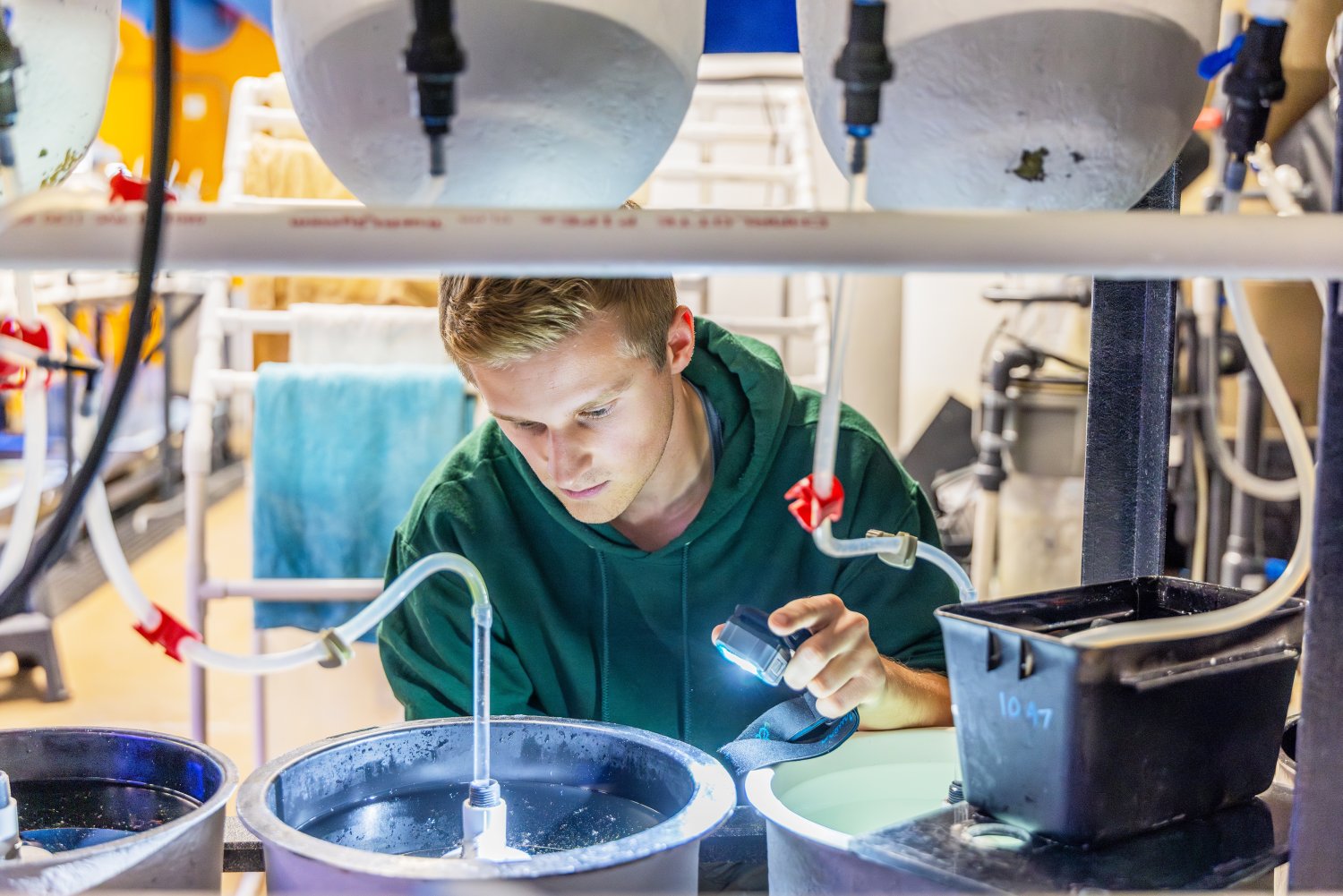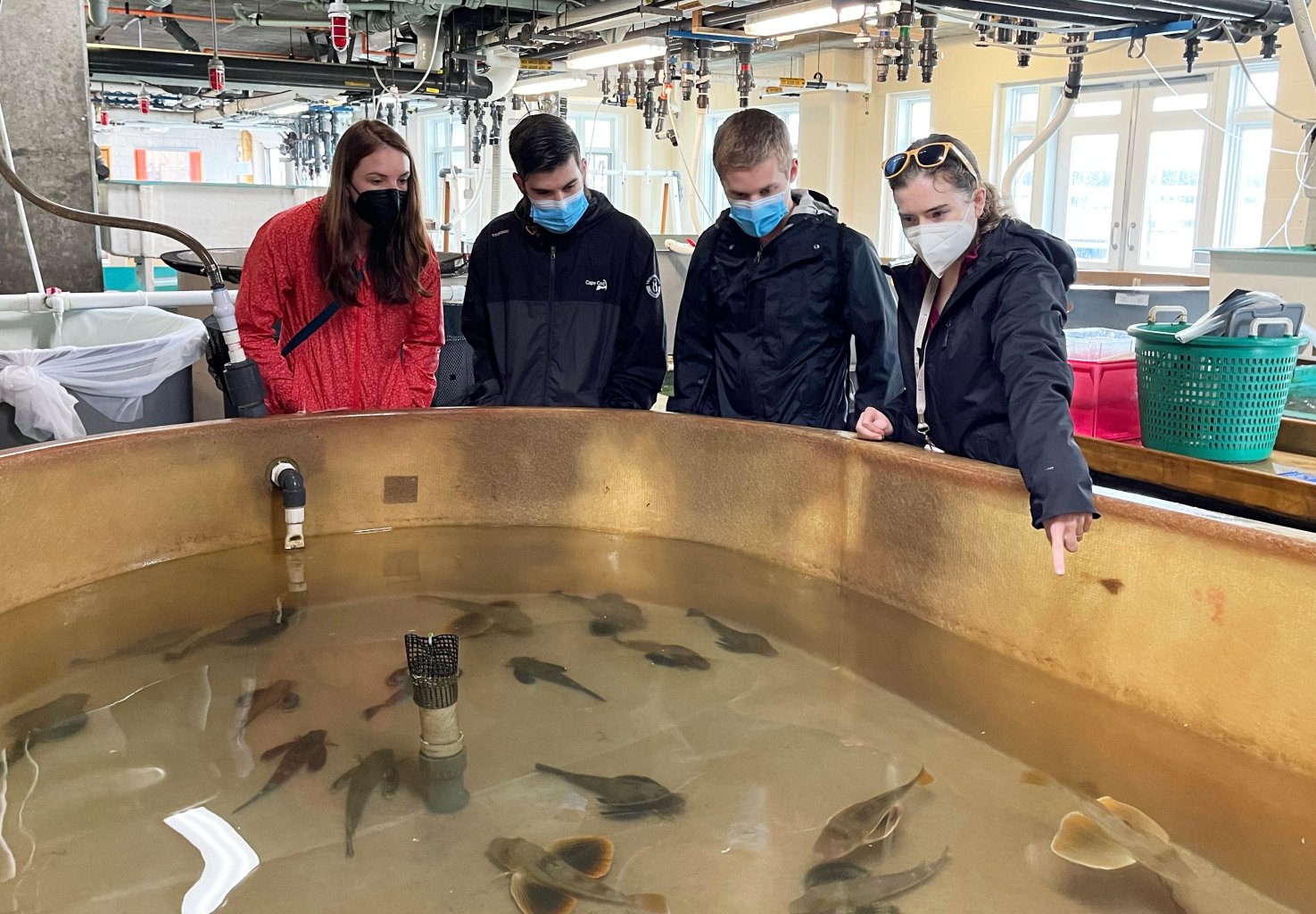Undergraduate Student Becomes Published Researcher in Evolutionary Biology
Through hands-on research opportunities at RWU, senior Joshua Sears contributed to a study on sea robins that has garnered national attention, showcasing the university’s commitment to providing students real-world research opportunities.

BRISTOL, R.I. – As a first-year student at Roger Williams University, Joshua Sears could not have known that his first research experience would propel him to become a published author on a study covered by The New York Times months before he had even graduated with his bachelor’s degree.
Led by Stanford University postdoctoral researcher Amy Hebert and Harvard Medical School professor Corey Allard, the groundbreaking research that Sears collaborated on focused on the molecular mechanisms behind evolutionary adaptations in sea robins. This bottom-dwelling marine fish species exhibits a range of fascinating traits, including wing-like pectoral fins and specialized leg-like appendages that allow them to walk, dig, and detect food on the ocean floor.
But how and why these traits evolved remained uncertain, until now. The study, “Ancient developmental genes underlie evolutionary novelties in walking fish,” which was published in Current Biology in October, provides new insights into the molecular underpinnings of evolutionary change, showing how genetic mutations in sea robins led to these novel features, which allow the fish to adapt to their environment in ways that other fish species cannot. The findings shed light on the broader principles of evolutionary biology, exploring how trait gain plays a role in shaping the development of new features in animals.

Sears’ authorship on the published paper reflects Roger Williams University’s dedication to fostering undergraduate participation in advanced research, offering opportunities often reserved for graduate students at other institutions. In addition to Sears, Andrew Rhyne, RWU Professor of Marine Biology, and Allex Gourlay ’15, Research Associate at RWU’s Center for Economic and Environmental Development (CEED), were also co-authors on the research publication.
“It's incredible for any undergraduate student to contribute to a project that leads to publication, and Josh's involvement is no exception. He joined the team at a critical time, and his work was pivotal in helping gather the data necessary for the study,” said Gourlay. “I truly hope this experience opens doors for more undergrads like Josh, allowing them to learn invaluable skills and explore new opportunities.”
Empowering Students Through Research
Sears’ entry into the world of scientific inquiry began during his first year, with a work-study position at RWU’s Wet Lab. There, he was introduced to an exciting opportunity by Gourlay, who encouraged Sears to take on a greater role in a long-term project.
Raising sea robins from eggs to juveniles was a pivotal part of the research responsibilities for Sears, now a senior Marine Biology major with minors in Aquaculture & Aquarium Science and Mathematics from Bedford, N.H. For weeks, he managed the fish husbandry process, ensuring that the sea robins had the optimal environment to develop. He meticulously maintained tanks, monitored water salinity, and prepared live food, even counting the microscopic copepods (also raised in the Wet Lab) to ensure proper feeding levels.
“It’s like growing a plant from a seed, except even more rewarding,” Sears said. “Having the opportunity (as a first-year student) to culture the fish really gave me a step ahead. It’s a skill you don’t typically learn elsewhere.”

As the project expanded over the course of several summers, Sears trained students and staff to assist, freeing him to focus on other aspects of the research, which included collaborating closely with the lead researcher, Hebert. This hands-on role not only made the pioneering study possible but also gave Sears invaluable experience working alongside professionals from renowned institutions like Harvard and Stanford.
“Amy (Hebert) taught me how to approach research with a sense of curiosity and gave me a glimpse into what postdoc lab work is like,” Sears said. “I’m sure we’ll stay in touch, and I hope she’ll be able to help with a recommendation down the line. Building those kinds of connections is really important, and I’m thankful for the opportunity to work with her.”
A Legacy of Research Excellence
This trailblazing examination unfolded in part at Roger Williams University because of its distinct expertise in aquaculture and fish husbandry. Over half a decade, Amy Hebert conducted her analysis at RWU through fellowships and dedicated lab space, where she relied on the university’s trained personnel and advanced capabilities to support the project’s complex needs. The Wet Lab’s resources, combined with the university’s reputation for fostering undergraduate research, made RWU an ideal setting to raise sea robins for genetic study.
“Our specialized facilities and expertise in fish husbandry made RWU a natural partner for Amy’s research,” Gourlay said. “Through a productive collaboration, our team raised the fish to key developmental stages, providing the foundation for Amy to conduct her genetic studies. This project is a perfect example of RWU's ability to support innovative research.”

For Sears, the journey from Wet Lab assistant to published author remains surreal, but it has deepened his passion for science and fueled his desire to continue pursuing experimentation in the field. Looking ahead, he plans to build on this experience, further developing his expertise and contributing to sustainable solutions for environmental challenges.
“It’s definitely weird, and sometimes I will get a random email that says, ‘Dr. Sears,’ and I don’t have my doctorate or any Ph.D., but I’m flattered,” he said with a laugh. “It’s really interesting and cool, honestly, because if you had asked me when I first started college if I was going to be published before I even got out of college, I would have said, ‘You’re crazy,’ because there’s no way that would happen. But it did.”
